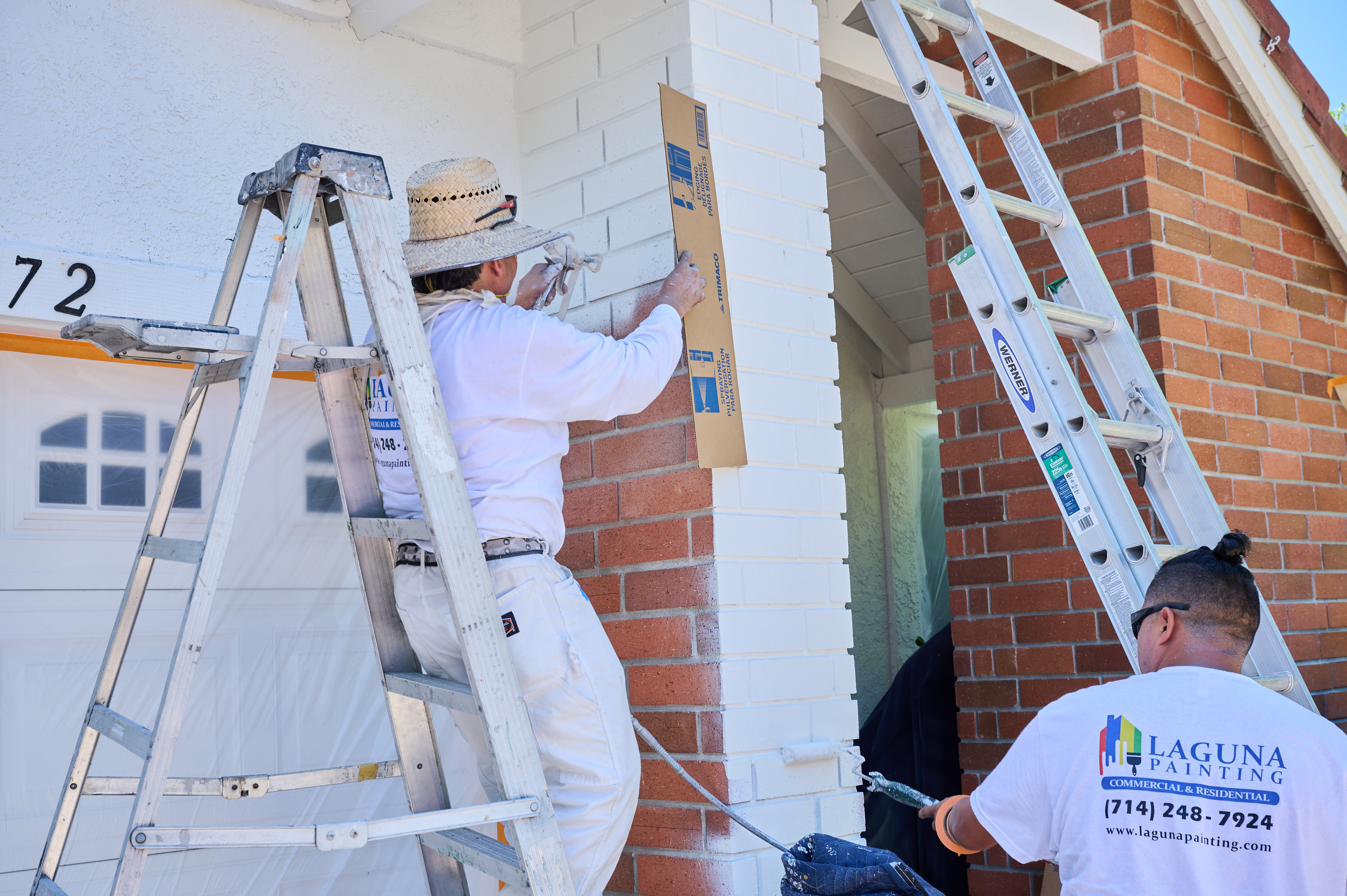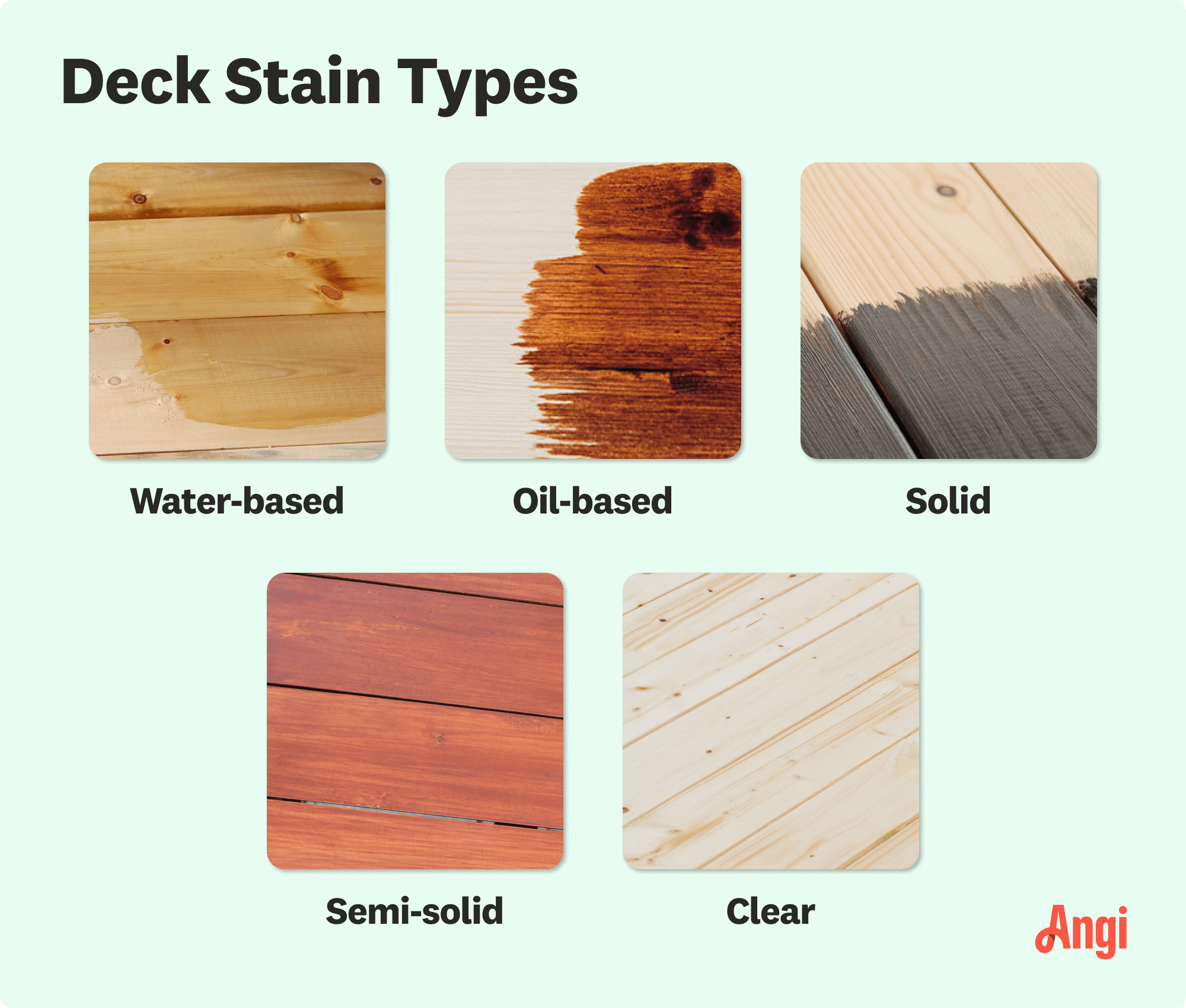
Painting a brick house typically costs between $1.40 and $4.20 per square foot. Your total cost will depend on where you live and the finish you use.
The right stain can bring a whole new life to your wood


Stain can take anywhere from two to 24 hours to dry.
It can take one to seven days for stain to fully cure.
Drying times vary based on the type of wood and stain.
Water-based stains take less time to dry than oil-based stains.
Low humidity and adequate ventilation help to dry stains.
Whether you’re refinishing the deck or your kitchen cabinets, stain protects your wood and keeps it looking beautiful. But it can be difficult to properly plan your project if you don’t know how long it will take for the stain to dry.
The type of wood, the stain, and environmental conditions all affect how long it takes for wood stain to dry. In this guide, you’ll learn more about the drying time for stain and what you can do to speed up the process.
Deck stains may contain flammable solvents and VOCs. Use in well-ventilated areas, and always wear gloves and protective clothing.
Stain typically takes two to 12 hours to dry and 24 to 72 hours to cure fully, but dry times can vary significantly based on the product. You can usually apply a second coat after the initial dry time, but you’ll want to wait to put on polyurethane (which further protects your beautiful wood items from damage) until after the stain fully cures.
So what’s the difference between drying and curing? Drying is the minimum time it takes for you to be able to safely apply another coat of stain, while curing is the time it takes for the stain to fully dry, harden, and be safe for everyday use.

The type of stain and what it’s made out of determines how long it needs to dry and cure. No matter what stain you use, always check your manufacturer’s details to ensure the best result and give the stain more time to cure rather than less.
| Type of Stain | Dry Time |
|---|---|
| Water-based | 24–48 hours |
| Oil-based | 12–24 hours |
| Gel-based | 24+ hours |
Water-based stains typically dry within three to four hours, but they’ll require an additional 24 to 48 hours to cure fully. These types of stains have a water-based solvent with a water-soluble dye. They’re reasonably hardy against the elements but not quite as durable as oil-based stains. Since they’re water-based, they will take longer to dry in environments with high humidity levels.
| Pros | Cons |
|---|---|
| Fast drying time | 48 hours to fully cure |
| Easy cleanup | Less durable |
| Low odor | Humidity impacts drying |
Oil-based stains take longer to dry than water-based stains, with an average drying time of 12 to 24 hours. They’ll also need an additional 72 hours to cure fully. These typically use linseed oil as a carrier to help the dye soak into and bond with the wood. Since they’re more durable than water-based stains, they’re ideal for outdoor projects such as decks, playground equipment, and more.
| Pros | Cons |
|---|---|
| Long-lasting finish | Slow drying time |
| Great for outdoors | 72 hours to fully cure |
| Deep wood penetration | Harder to clean up |
Gel stains have the longest drying time, taking up to 24 hours to dry and as much as one week to fully cure. The viscosity of these stains makes them especially forgiving and easy to apply, and they disguise flaws in the wood without the need to sand.
| Pros | Cons |
|---|---|
| Hides wood flaws | Longest dry time |
| Easy to apply | 1 week to fully cure |
| No need to sand first | Thick, slow to spread |

Just like every wood project is unique, so is every type of wood. Your dry time may vary based on the material you use, so be sure to research before embarking on your next project. Here’s a breakdown of typical stain dry time by types of wood and where you may use them.
| Type of Wood | Dry and Cure Time |
|---|---|
| Hardwood | 24–48 hours |
| Softwood | 12–72 hours |
| Pressure-treated | 24–48 hours |
Stain on hardwood takes between four and eight hours to dry and needs 24 to 48 hours to cure fully. Hardwood dries quicker than softwood, although hardwood may need two or more coats to achieve even coverage.
Common hardwood species include hickory, oak, maple, mahogany, cherry, walnut, alder, teak, ipe, and cumaru. These woods are well-suited for outdoor projects such as decks, fences, and porches. You can also use them to construct furniture, although they’re more rigid and can be difficult to work with.
Stain on softwood usually takes 10 to 12 hours to dry and up to 72 hours to cure fully. Since softwood is more porous, it’s a good idea to use a pre-stain wood conditioner beforehand to ensure even coverage.
Common softwood species include pine, cedar, fir, juniper, redwood, spruce, and yew. These are ideal for common household projects such as furniture, windows, doors, baseboards, and shoe molding. They won’t stand up to the elements, so they must be chemically treated if you’re using them outdoors.
Stain on pressure-treated wood takes about the same time to dry as hardwood, typically four to eight hours. It will take about 24 to 48 hours to cure fully. Actual curing time will depend on the surrounding conditions, including ventilation, humidity, and temperature.
Common species used for pressure-treated wood include southern yellow pine, red and ponderosa pine, Douglas fir, and hem fir. This type of wood is an excellent and affordable option for outdoor projects such as decks, fences, porches, playground equipment, sheds, garden boxes, and treehouses.
The drying time for stain depends on the conditions around your project, such as temperature, humidity, and airflow.
When applying any stain, aim for a temperature between 50 and 80 degrees Fahrenheit. Colder temperatures inhibit the stain from penetrating the wood, and warmer temperatures cause drying to slow down.
If you can easily control the temperature inside, use that to your advantage. If not, use fans or heaters to get the temperature as close to this range as possible.
Elevated humidity causes stain to dry more slowly because it takes longer for the moisture to leave the stain. This factor is especially true for water-based stains. Use a dehumidifier in a basement, or plan your outdoor staining on a day with low to moderate humidity.
Good airflow helps stain dry. Consider opening windows and doors and running a fan to help circulate the air in your workspace.
Rain, hail, snow, and wind storms can impact how fast and smooth your stain dries. Plan your outdoor staining projects, such as your deck or wood fence, for at least three dry, moderate-weather days.
Thin coats of stain allow for better and faster drying. Thick strokes could make your finish look blotchy and take longer to dry. You should let most stains sit for five to 15 minutes so they absorb into the wood. Then, wipe off excess stain with a lint-free rag.
You can get a wood stain to dry faster by ensuring the optimal drying environment. But don’t forget to let the stains fully cure to ensure longevity and a smooth finish.
Allow the wood to dry completely after cleaning or pressure-washing before applying stain.
Choose a moderate-temperature day between 50 and 80 degrees Fahrenheit with average to low humidity.
Increase air circulation by opening windows and doors and turning on a fan.
Apply thin, even coats and wipe off excess stain with a lint-free cloth after letting the stain soak into the wood.
Use a space heater to warm a cool area, such as a basement or garage.
Read and follow the instructions on your wood stain for the best result.
By following these tips, you can confidently complete a DIY wood staining project. However, if it seems like a lot to remember, you can call a pro, like a local deck refinisher or deck painter near you, to tackle the job.
The cost to stain a deck ranges from $550 to $1,250, with a national average of $850. The things to consider that could tip the scales on the cost of your deck staining project are its size, condition, material, and any additional factors like pressure washing or waterproofing.
A 250-square-foot deck in average condition costs between $250 and $625 to stain, but keep in mind that add-on work could add up to about $800, including labor and materials.
Staining a deck isn’t necessarily a difficult project, but it takes a professional hand to avoid errors that could cost you much more time and energy later. If you aren’t sure of your ability or don’t feel up to the labor, contact local deck staining contractors to get it done—you’ll lower your chances of a redo within the next few years.
From average costs to expert advice, get all the answers you need to get your job done.

Painting a brick house typically costs between $1.40 and $4.20 per square foot. Your total cost will depend on where you live and the finish you use.

The cost of materials and labor all factor into your overall brick staining cost, but what other factors impact the bottom line? Our guide covers this and more.

The cost to paint a house's exterior depends on its size, siding type, and height. The finish and the home's exterior condition also play a role.

Discover how to whitewash brick to enjoy its timeless charm and naturally protective properties.

What is the best type of paint for exterior homes? Keep reading to narrow down your paint options once and for all.

Deciding on the best fence paint color is difficult. This guide will help you choose a shade that creates the right vibe alongside your house color and landscaping.